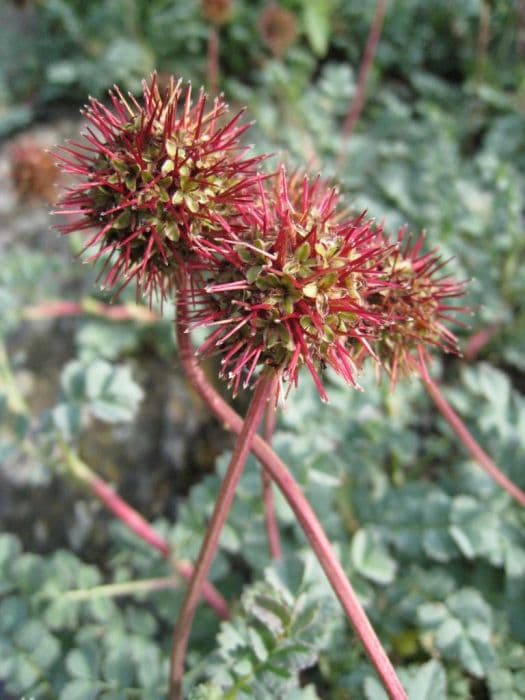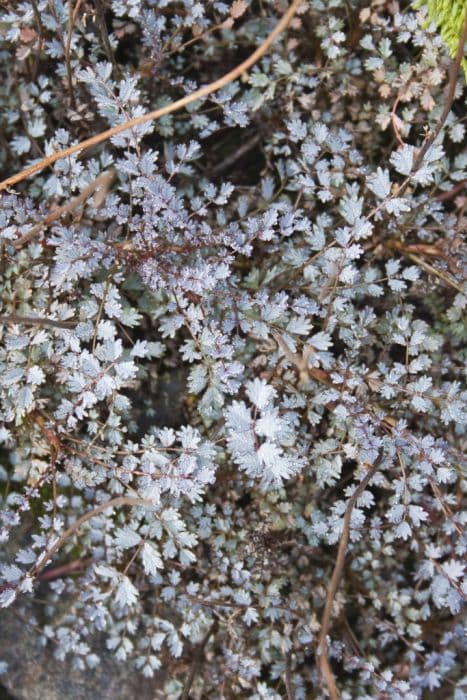Paul Transon Rose Rosa 'Paul Transon' (Ra)

ABOUT
The Rosa 'Paul Transon' is a visually striking plant that features luscious blooms with a distinctive appearance. This rose variety, commonly known as the 'Paul Transon Rose', boasts blossoms that are immediately recognizable for their sumptuous, ruffled petals, which create a sense of depth and volume. The petals unfurl in a densely packed, intricate display, giving each flower a lavish and romantic feel. The color of the 'Paul Transon Rose' is a captivating mix of warm hues. The petals present a beautiful blend of pinks and apricots, often with a gradation of color that shifts from the outer petals to the inner ones. This tonal variation adds a dynamic appeal to the flowers, making them stand out in a garden display. Moreover, the blossoms are typically complemented by a lush background of dark green foliage. The leaves are glossy and provide a perfect backdrop for the flowers, accentuating their color. The 'Paul Transon Rose' is famous not only for its beauty but also for its fragrance. The flowers emit a delightful scent that can be described as sweet and heady, contributing to the overall sensory experience of the plant. While in bloom, the roses can serve as an enchanting focal point in any garden, inviting onlookers to take a closer look and indulge in their fragrant aroma. This rose variety is often incorporated into garden designs that aim to evoke a sense of classic beauty and timeless elegance. Its distinctive flowers and delightful fragrance make it a favorite among gardeners and rose enthusiasts who appreciate its unique aesthetic qualities.
About this plant
 Names
NamesFamily
Rosaceae.
Synonyms
Paul Transon Rose, Bourbon Rose.
Common names
Rosa 'Paul Transon'
 Toxicity
ToxicityTo humans
The Rosa 'Paul Transon', commonly known as the Rambler Rose, is not considered toxic to humans. It is generally safe to handle and plant parts are not known to be poisonous if ingested. However, the thorns on the Rambler Rose can cause physical injury if not handled with care.
To pets
The Rosa 'Paul Transon', commonly known as the Rambler Rose, is also not considered toxic to pets. Similar to humans, the main concern with pets is the physical danger posed by the thorns, which can cause injury if a pet attempts to chew on the branches or dig around the plant. There are no known toxic effects from pets ingesting parts of the Rambler Rose.
 Characteristics
CharacteristicsLife cycle
Perennials
Foliage type
Deciduous
Color of leaves
Green
Flower color
Pink
Height
10 feet (3 meters)
Spread
6 feet (1.8 meters)
Plant type
Climber
Hardiness zones
6
Native area
Cultivar
Benefits
 General Benefits
General Benefits- Aesthetic Appeal: Adds visual interest to gardens with its unique and attractive blooms.
- Fragrance: Offers a pleasant aroma which enhances the sensory experience of a garden.
- Habitat for Wildlife: Attracts beneficial insects such as bees and butterflies that pollinate other plants.
- Shade and Shelter: Can provide shade for smaller plants and a sheltered area for wildlife.
- Landscape Design: Used in various garden design strategies, including formal gardens, borders, and as standalone features.
- Cultural Significance: Often associated with beauty and love, which can enrich the cultural atmosphere of a garden.
 Medical Properties
Medical PropertiesThis plant is not used for medical purposes.
 Air-purifying Qualities
Air-purifying QualitiesThis plant is not specifically known for air purifying qualities.
 Other Uses
Other Uses- Rosa 'Paul Transon' can be used in potpourri for its petals' delicate scent to freshen up drawers and wardrobes.
- The petals of this rose can be pressed and used in crafting, such as creating personalized stationary or bookmarks.
- Due to its climbing habit, Rosa 'Paul Transon' can be trained to grow over unsightly structures, providing an aesthetic cover-up.
- Rosehips, the fruit of roses, can be used to make natural dyes for fabric and craft projects.
- The rose's sturdy canes can be repurposed as natural supports for other plants in the garden.
- Its flowers can be used to add a colorful, edible garnish to desserts and salads.
- The petals can be frozen in ice cubes to create visually appealing additions to cold beverages.
- These roses can be used in creating floral waters or scented bath soaps.
- The thorns of Rosa 'Paul Transon' can be collected and used in traditional crafts or as natural needles for small-scale sewing projects.
- Gardeners can create living fences or privacy screens by planting this vigorous climber in strategic locations.
Interesting Facts
 Feng Shui
Feng ShuiThe Rose is not used in Feng Shui practice.
 Zodiac Sign Compitability
Zodiac Sign CompitabilityThe Rose is not used in astrology practice.
 Plant Symbolism
Plant Symbolism- Love: Roses are universally regarded as a symbol of love, often associated with romantic gestures and expressions of deep affection.
- Beauty: The Rosa 'Paul Transon' is admired for its beautiful blooms, reflecting the general association of roses with beauty and perfection.
- Mystery: With its unique cascading habit and lush blooms, this particular rose variety may evoke a sense of mystery or the enchanting allure of a secret garden.
- Passion: Roses, especially those with deep and vibrant colors, are often symbolic of passion and strong emotional bonds.
- Honor: Gifting roses can be a way to honor someone, showing respect or celebrating their achievements or contributions.
- Devotion: Roses are frequently used to represent steadfastness and loyalty, particularly in romantic relationships.
- Friendship: While different colors of roses can symbolize varied nuances of relationships, some roses signify friendship and the joy that comes with lasting companionship.
 Water
WaterFor a Paul Neyron rose, ensure the soil is kept consistently moist during the growing season, typically by providing about 1 inch of water weekly. It's essential to water deeply to encourage strong root development, so apply water directly to the base of the plant, avoiding wetting the foliage to prevent fungal diseases. During hot, dry spells, you may need to water twice a week. Cut back on watering as the plant prepares for dormancy in the fall, and in winter, only water if there is an extended dry spell.
 Light
LightPaul Neyron roses require full sun to flourish, so plant them in a location that receives at least six hours of direct sunlight daily. Avoid too much shade as it can reduce blooming and increase susceptibility to pests and diseases. A spot with morning sun is ideal as it dries dew promptly, which can help prevent fungal infections.
 Temperature
TemperaturePaul Neyron roses thrive in a moderate climate with temperatures ranging between 40 to 90 degrees Fahrenheit. They can survive temperatures slightly below 40 degrees but require protection or mulching in colder climates. The ideal growing condition is a region where daytime temperatures are warm but not excessively hot, and nighttime temperatures are cool.
 Pruning
PruningPrune Paul Neyron roses in late winter or early spring, when the buds begin to swell but before they leaf out. Remove dead or diseased wood, any crossing or rubbing branches to promote good air circulation, and cut back remaining canes by about one-third to one-half to invigorate growth. Deadheading spent flowers during the blooming season encourages more blooms. Annual pruning helps maintain the plant's shape, health, and productivity.
 Cleaning
CleaningAs needed
 Soil
SoilRambler roses like the 'Paul Transon' prefer well-draining, fertile loam with a pH between 6.0 and 6.5. A good soil mix would be one-third each of topsoil, compost, and a coarse material like perlite or sand to aid drainage.
 Repotting
RepottingRambler roses such as 'Paul Transon' do not commonly need repotting as they are typically planted outdoors. If grown in containers, however, repotting every 2 to 3 years may be necessary to refresh the soil.
 Humidity & Misting
Humidity & Misting'Paul Transon' roses, being rambler roses, are tolerant of a wide range of humidity levels and do not require specific humidity conditions outdoors.
 Suitable locations
Suitable locationsIndoor
Ensure full sun through a southern window and ample airflow.
Outdoor
Full sun, enrich soil with compost, provide support for climbing.
Hardiness zone
5-9 USDA
 Life cycle
Life cycleRosa 'Paul Transon', commonly known as Ra, begins its life cycle as a dormant bare-root plant or as a potted plant with young canes. Upon planting, it enters a growth phase where it develops a strong root system and vegetative growth, including leaves and stems. The plant then enters the flowering stage during spring and summer, showcasing its fragrant, colorful blooms in cycles that may repeat until fall. After flowering, if pollination occurs, the plant may produce hips (seed pods) that, if properly ripened and sown, can give rise to new plants. In the fall, Ra prepares for dormancy by slowing growth and eventually shedding leaves if the climate is conducive to a dormant season. The plant remains dormant during winter, conserving energy to restart its cycle with vigorous growth in the following spring.
 Propogation
PropogationPropogation time
Spring-Early Summer
Propogation: The Rosa 'Paul Transon', commonly known as the rambler rose, is typically propagated by semi-hardwood cuttings. Semi-hardwood cuttings are best taken in late summer to early fall, when the stems are partially matured yet still flexible. The most popular method of propagation is by taking cuttings about 6 to 8 inches (15 to 20 centimeters) long from healthy, disease-free plants. Each cutting should have at least two or three sets of leaves. The bottom of the cuttings is dipped in rooting hormone to enhance root development and then planted in a well-draining soil mixture. High humidity is maintained around the cutting, usually by covering the pot with a plastic bag or placing it in a greenhouse, to prevent the leaves from drying out until roots have formed this may take several weeks to a few months. Once the cuttings have established a strong root system, they are potted on or moved to their final planting location.









